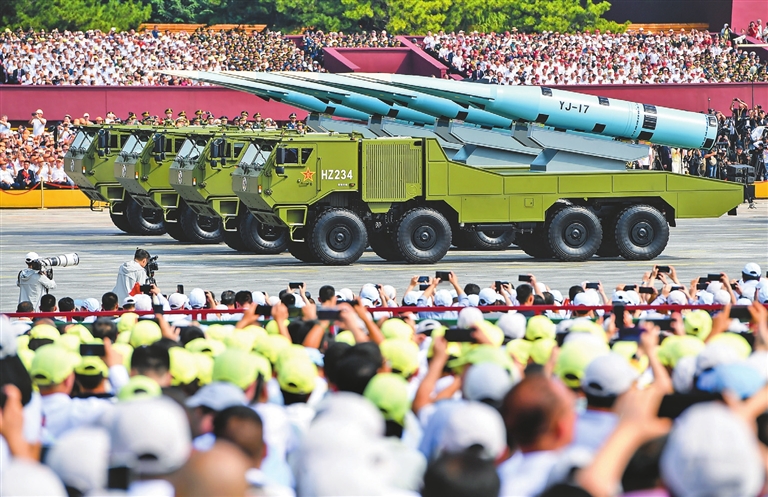
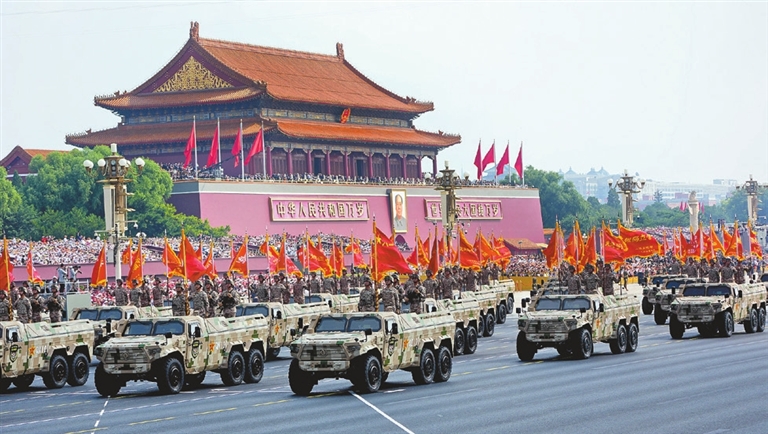
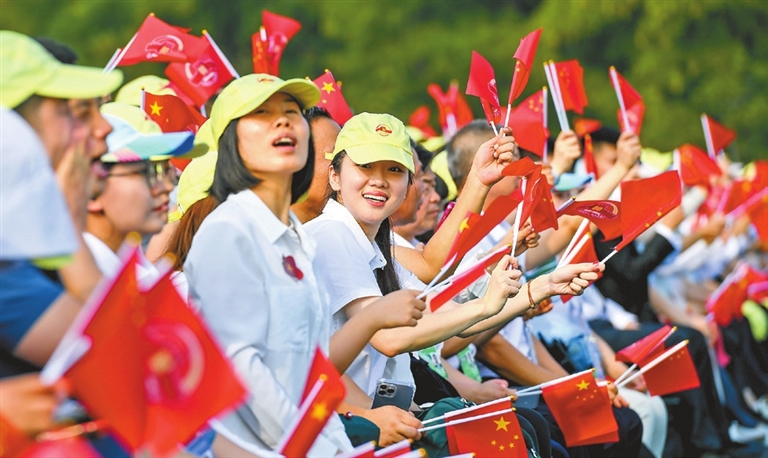
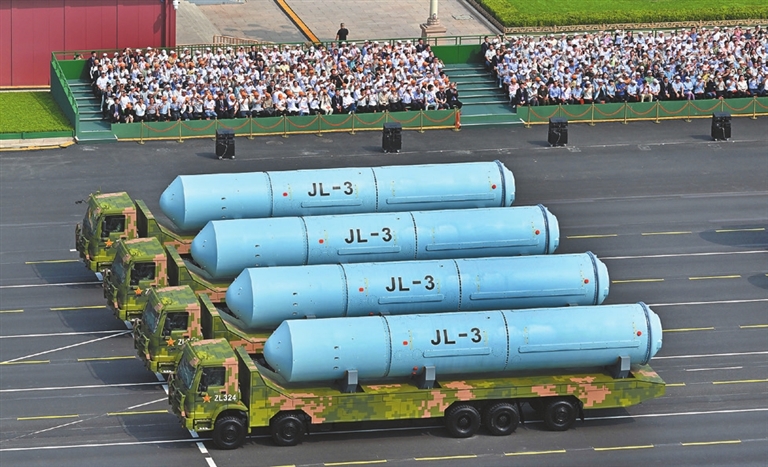
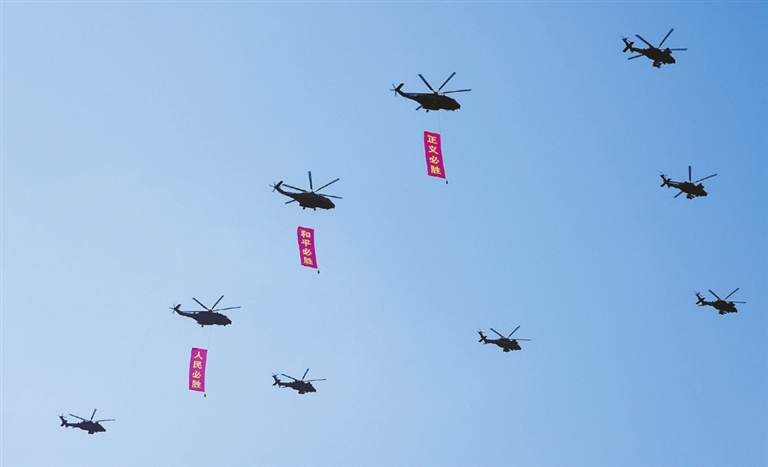
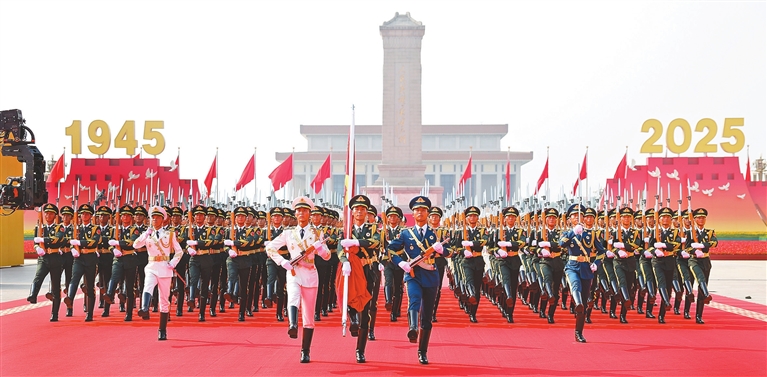
CHINA held a massive military parade in central Beijing yesterday to mark the 80th anniversary of its victory in World War II, pledging the country’s commitment to peaceful development in a world still fraught with turbulence and uncertainties. Towering structures shaped like the Great Wall stood in Tian’anmen Square, symbolizing the Chinese nation’s courage and solidarity in resisting foreign aggression. President Xi Jinping, also general secretary of the Communist Party of China Central Committee and chairman of the Central Military Commission, oversaw the parade and reviewed the troops. Standing beside Xi on Tian’anmen Rostrum were Russian President Vladimir Putin and Kim Jong Un, the top leader of the Democratic People’s Republic of Korea, along with more than 20 other foreign leaders. Representatives of people who had supported China’s WWII fight, or their family members — from countries such as Russia, the United States, the United Kingdom, France, and Canada — were invited to the event. This was the second time since 2015 that China has held a military parade to commemorate the hard-won victory in the Chinese People’s War of Resistance Against Japanese Aggression and the World Anti-Fascist War. Helicopters flew over Tian’anmen Square carrying banners that read “Justice Prevails,” “Peace Prevails,” and “The People Prevail.” The troops marched in tight, powerful formations, their faces lit with confidence and pride. Columns of new tanks, artillery, and other military equipment rumbled through the square. Xi delivered a speech before the parade. Highlighting the significance of the victory 80 years ago, Xi said it marks China’s first complete victory against foreign aggression in modern times. Xi noted that the Chinese people made a major contribution to the salvation of human civilization and the defense of world peace with immense sacrifice in the war. He called on nations to “eliminate the root cause of war and prevent historical tragedies from recurring.” Japan officially surrendered Sept. 2, 1945 by signing the Instrument of Surrender. China designated Sept. 3 as Victory Day. An 80-banner formation honoring heroic military units from the war marched past Tian’anmen Square, highlighting China’s position as the first country to rise against fascist aggression with the longest-lasting resistance that began in 1931. The country tied down and struck over half of Japan’s overseas forces, at the cost of 35 million military and civilian casualties — accounting for around one-third of all WWII casualties worldwide. A total of 45 formations and echelons were involved in the grand parade, during which march-past, airborne flag-guarding echelons, foot formations, battle flag formations, armament columns, and aerial echelons passed through or flew over Tian’anmen Square in order. More than 10,000 military personnel, along with over 100 aircraft and hundreds of ground armaments, were arranged into these formations according to a wartime command system. The People’s Liberation Army’s (PLA) new system of services and arms — the result of military reforms under Xi’s leadership — was put on display for the first time. The new system of services and arms comprises four services of the Army, the Navy, the Air Force, and the Rocket Force, as well as four arms of the Aerospace Force, the Cyberspace Force, the Information Support Force, and the Joint Logistics Support Force. The advanced armaments put on display included unmanned intelligence and counter-unmanned equipment, hypersonic missiles, directed-energy weapons, electronic jamming systems, and strategic weaponry capable of global strikes. In his speech, Xi demanded that the PLA provide strategic support for the rejuvenation of the Chinese nation. He asked the PLA to build itself into world-class forces and resolutely safeguard national sovereignty, unity, and territorial integrity. Xi reiterated China’s commitment to peaceful development. “Humanity is again faced with a choice of peace or war, dialogue or confrontation, and win-win outcomes or zero-sum games,” he said. The Chinese people will stand firmly on the right side of history and on the side of human progress, adhere to the path of peaceful development, and join hands with the rest of the world to build a community with a shared future for humanity, he said. Chinese soldiers who have participated in U.N. peacekeeping operations marched past Tian’anmen Square, marking their first appearance in a V-Day parade. “We have the capability to defend the peace forged with the blood of our forefathers,” said Shao Xiaoguang, a member of the reviewed troops who previously served on a peacekeeping mission in the Democratic Republic of the Congo. This was also the first military parade since Xi led China to embark on “a new journey to pursue Chinese modernization on all fronts.” The country has laid out a roadmap to basically achieve modernization by 2035. “Eighty years ago, we were revived. Eighty years later, we are thriving with even greater vitality,” said Lyu Shouye, a spectator at the event and a graduate student studying AI. “Now our country has reached a stage where we need to undertake greater responsibilities,” he said. (Xinhua) Some highlights of the parade • The nuclear triad, which included JingLei-1 air-based long-range missile, JuLang-3 submarine-launched intercontinental missile, and DongFeng-61 land-based intercontinental missile. • ChangJian-20A, YingJi-18C, and ChangJian-1000 cruise missiles, which have long-range precise strike and multi-domain deterrence capabilities. It is the first time the cruise missiles of the PLA Navy, Air Force, and Rocket Force units formed a joint formation in parade. • Hypersonic anti-ship missiles, including YingJi-19, YingJi-17, and YingJi-20. • A series of air defense weapons, including HongQi-20, HongQi-19, and HongQi-29. These systems are capable of multi-phase and multi-layered missile interception, as well as air defense at long, medium, and short ranges. • Four types of cyberspace warfare equipment, which can consolidate cyber defense and empower all-domain operations. • Sea-based unmanned warfare equipment, including China's new-type unmanned underwater vehicle, boat, and mine-laying system. (Xinhua) | 
